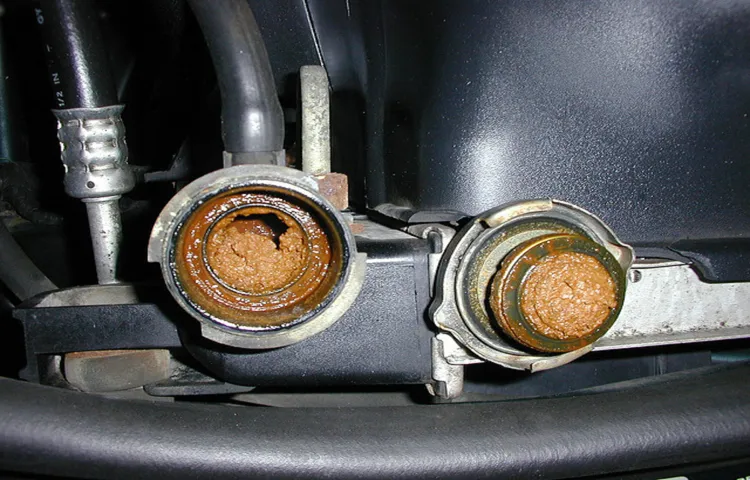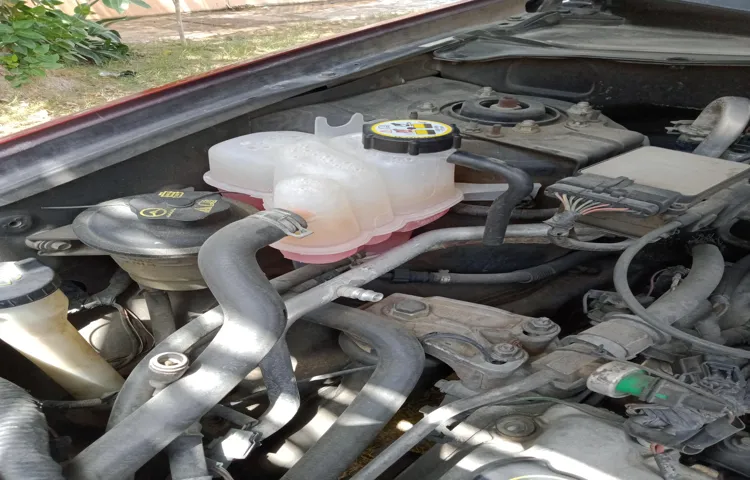Have you ever noticed your coolant levels dropping for no apparent reason? It can be frustrating, especially if you have no idea where your coolant is disappearing to. While it may seem like a small issue, low coolant levels can lead to engine overheating and serious damage. But fear not, troubleshooting the whereabouts of your coolant is easier than you think.
In this guide, we’ll dive into the common reasons why your coolant levels may be diminishing and how to rectify them. Think of it like playing detective, uncovering clues to solve the coolant mystery. So, let’s roll up our sleeves and get started on this troubleshooting adventure!
Table of Contents
Symptoms of Coolant Loss
If you’re wondering where your coolant goes, one possibility is that it’s leaking out of your engine. Coolant is essential for regulating your engine’s temperature and preventing it from overheating, so if you notice that your car is running hot or that steam is coming out from under the hood, you may have a coolant leak. Other symptoms of coolant loss include a sweet, syrupy smell inside the car, a low coolant level in the reservoir, and white smoke coming out of the exhaust pipe.
If you suspect that you have a coolant leak, it’s important to have your car inspected by a mechanic as soon as possible. Driving with a low or empty coolant level can cause serious engine damage and potentially even a total breakdown.
Low coolant levels
Low coolant levels can have serious consequences on your car and its engine, causing potential overheating and damage. One of the most common symptoms of a coolant loss is an illuminated temperature warning light on your dashboard. This warning can indicate that your engine is running hot and requires immediate attention.
Additionally, you may notice steam or white smoke coming from under the hood, along with a sweet aroma that comes from leaking coolant. Other signs of low coolant levels include poor engine performance, decreased fuel efficiency, and a reduction in overall power. To prevent these issues from occurring, it’s essential to regularly check your coolant levels and top them off as needed.
If there’s a significant loss of coolant, it’s crucial to bring your car to a mechanic right away to pinpoint the root cause of any leaks or issues within the engine.

Overheating engine
An overheating engine can be a major inconvenience and even lead to costly repairs if left unchecked. One of the common causes of engine overheating is coolant loss. If your engine is running hotter than usual, it could be due to low coolant levels caused by a leak or evaporation.
Look out for steam coming from the engine or a sweet smell coming from the exhaust pipe, as these are signs that your coolant is leaking. You may also notice that your engine temperature gauge is higher than normal, or the dashboard warning light illuminates. If you ignore these symptoms, you risk damaging your engine, which can be expensive to repair.
It’s important to get your engine checked as soon as possible if you suspect coolant loss, to prevent any further damage or inconvenience.
Sweet smell from engine
Have you ever noticed a sweet smell coming from your car’s engine? This could be a sign of coolant loss, which can lead to serious engine problems if left unaddressed. Coolant is the fluid that circulates through your engine, keeping it from overheating and maintaining a consistent operating temperature. When coolant levels are low, your engine can overheat, causing damage to various components and potentially leading to costly repairs.
Other symptoms of coolant loss include a visible leak under your car, steam coming from the engine, or the engine temperature gauge rising higher than normal. If you notice any of these signs, it’s important to have your car inspected by a qualified mechanic as soon as possible. Neglecting these warning signs can lead to permanent engine damage or even a complete engine failure.
Regular maintenance and inspections can help prevent these issues, so always stay on top of your car’s maintenance schedule. Remember, prevention is always better than a cure when it comes to car maintenance!
Common Causes of Coolant Loss
It’s quite worrying when your car’s coolant diminishes over time without any signs of leaking or an apparent cause. However, this issue is prevalent and visible in numerous cars. If you’re wondering where your coolant goes, it’s essential first to understand that engines don’t consume coolant.
The most common cause of coolant loss is through leaks, which can be caused by worn-out hoses, water pumps, and radiators. These leaks can occur due to excessive pressure, punctures, and rusting. Another cause can be a blown head gasket, which causes the coolant to be leaked into the engine or into the exhaust system.
Lastly, an overheating engine could cause the coolant to evaporate. Hence, it’s essential to get your car checked regularly by a professional mechanic to prevent any potential coolant loss due to malfunctioning engine components.
Leaking coolant hoses or radiator
Leaking coolant hoses or radiator If you notice that your vehicle’s engine temperature gauge is running hot or that there is a puddle of green liquid under your car, it could be a sign of coolant loss. One of the common causes of coolant loss is leaking coolant hoses or radiators. Over time, the hoses and connectors that carry coolant may become worn, cracked, or damaged, leading to leaks.
Hoses often deteriorate from heat and pressure, especially those located near the engine, and can become so brittle that they eventually crack and break. Similarly, the radiator can also be damaged from corrosion or an accident, resulting in leaks of coolant. It is important to have your coolant system regularly checked and maintained to prevent excessive wear and tear on the hoses and radiator, and to promptly address any leaks or damage.
So, if you notice coolant loss, do not ignore it and make sure to have it inspected by a mechanic. Remember, prevention is always better than cure!
Cracked engine block or cylinder head
If you’ve been experiencing a loss of coolant in your vehicle, it could be due to a cracked engine block or cylinder head. This occurs when the metal parts of the engine become compromised and allow coolant to leak out. One common cause of a cracked engine block is overheating, which can cause the metal to expand and contract rapidly, eventually leading to cracks.
Another potential cause is freezing temperatures, which can cause the coolant to freeze and expand, putting pressure on the engine’s components. It’s essential to address this issue promptly, as continued driving with a cracked engine block or cylinder head can cause significant engine damage and even complete failure. If you suspect that your vehicle has a cracked engine block or cylinder head, it’s best to take it to a qualified mechanic who can diagnose and repair the issue.
Don’t delay in forgoing this repair, as it can lead to even more costly damages in the long run.
Failed water pump
One of the common causes of coolant loss in vehicles is a failed water pump. This component is responsible for circulating coolant throughout the engine, preventing it from overheating. When a water pump fails, it can leak coolant or break altogether, causing the engine to overheat and potentially sustain damage.
Another potential cause of coolant loss is a damaged or worn radiator. This component is responsible for cooling the hot coolant as it passes through the system, and if it is damaged, it may not be able to do its job effectively. Additionally, a leaking or damaged head gasket can also be a culprit of coolant loss.
If the head gasket fails, coolant can leak into the combustion chamber and be burned off, leading to overheating and potential engine damage. Regular maintenance and inspections can help detect and prevent these issues, ensuring a longer lifespan for your vehicle.
Checking Your Coolant Levels
If you’re wondering where your coolant goes, it could be a sign that it’s time to check your coolant levels. Your coolant is an essential component of your car’s engine system, as it prevents your engine from overheating. Over time, your coolant levels can decrease due to evaporation or leaks in the system.
To check your coolant levels, locate your car’s radiator cap and remove it when the engine is cool. Inspect the coolant levels by looking at the markings on the side of the reservoir tank. If the levels are low, add a mixture of equal parts water and coolant to the right level.
Remember to only add coolant when the engine is cool to avoid the risk of burns. Regularly checking your coolant levels can help keep your car running smoothly and prevent damage to your engine.
Locating your coolant tank
Locating your coolant tank is important for checking your coolant levels and ensuring your vehicle runs smoothly. The coolant tank can usually be found near the radiator and is marked with a cap that is either yellow or black. It’s important to check your coolant levels regularly, especially before long trips or when you notice a decrease in your car’s performance.
To check your levels, simply unscrew the cap and use a dipstick to measure the amount of coolant. If you notice that the coolant is below the minimum level, it’s important to add more to avoid potential engine damage. Always make sure to use the recommended coolant for your vehicle and never mix different types, as this can cause damage to the engine.
By keeping an eye on your coolant levels, you can ensure that your vehicle runs smoothly and avoid costly repairs down the line.
Steps for checking coolant levels
Checking coolant levels is a simple yet important task that every car owner should do regularly. Doing this can help ensure that your engine stays cool and prevent overheating, which can lead to costly repairs. To check your coolant levels, start by locating the coolant reservoir under the hood.
Check the owner’s manual if you’re unsure where to find it. Once you’ve found the reservoir, check the level of the coolant inside. It should be between the minimum and maximum marks.
If the level is low, add more coolant until it reaches the maximum mark. Make sure to pay attention to the color of the coolant as well. It should be either green, pink, orange, or yellow, depending on the type of coolant used in your vehicle.
If it looks dirty or rusty, it may be time to get your coolant flushed and replaced. Checking your coolant levels may not seem like a big deal, but it could save you a lot of time and money in the long run. So, make it a habit to check it regularly to ensure that your car’s engine stays cool and healthy.
Conclusion
In the end, the answer to the question “Where does my coolant go?” is simple: it goes where it’s needed to keep your engine cool and running smoothly. Whether it’s being circulated through your radiator, running through your heater core to keep you warm on a chilly day, or simply keeping your engine from overheating on a hot summer afternoon, your coolant is always hard at work. And while you might not always see it or think about it, rest assured that your engine would quickly come to a screeching halt without this trusty liquid by its side.
So the next time you’re wondering where your coolant disappeared to, just remember: it’s out there, doing its job, and keeping your car running like a well-oiled machine.”
FAQs
Why does my car need coolant?
Your car needs coolant to regulate the temperature of the engine and prevent it from overheating.
How often should I check my coolant level?
It is recommended to check your coolant level at least once a month and before long trips.
What happens if my coolant level is too low?
If your coolant level is too low, it can cause your engine to overheat and potentially cause damage.
Can I use water instead of coolant in my car?
While water can be used in emergency situations, it is recommended to use a proper coolant mixture as it provides better protection against overheating and corrosion.
Where should I pour the coolant in my car?
The coolant should be poured into the coolant reservoir, which is usually located near the radiator under the hood.
How often should I replace my coolant?
It is recommended to replace your coolant every 2 to 3 years or as specified in your car’s owner manual.
What should I do if I notice my coolant level decreasing rapidly?
If you notice a rapid decrease in coolant level, it could be a sign of a leak in the system and it’s best to have it inspected by a professional mechanic.



